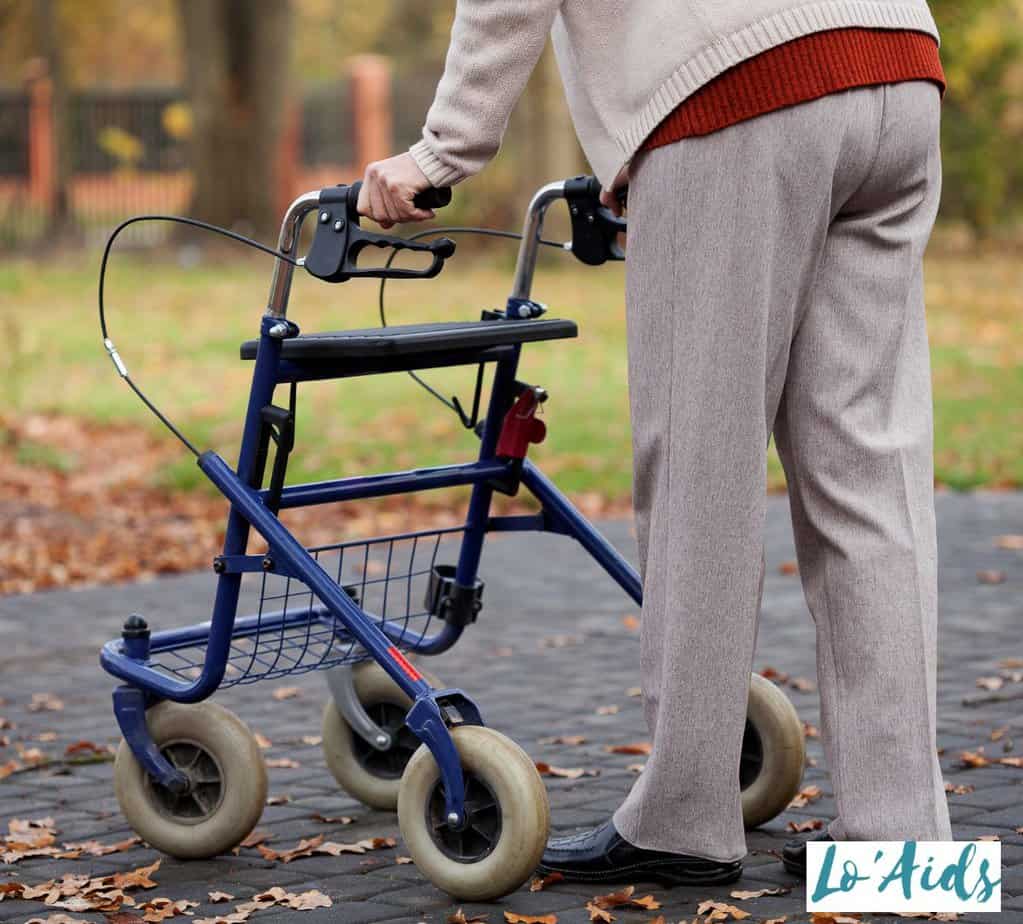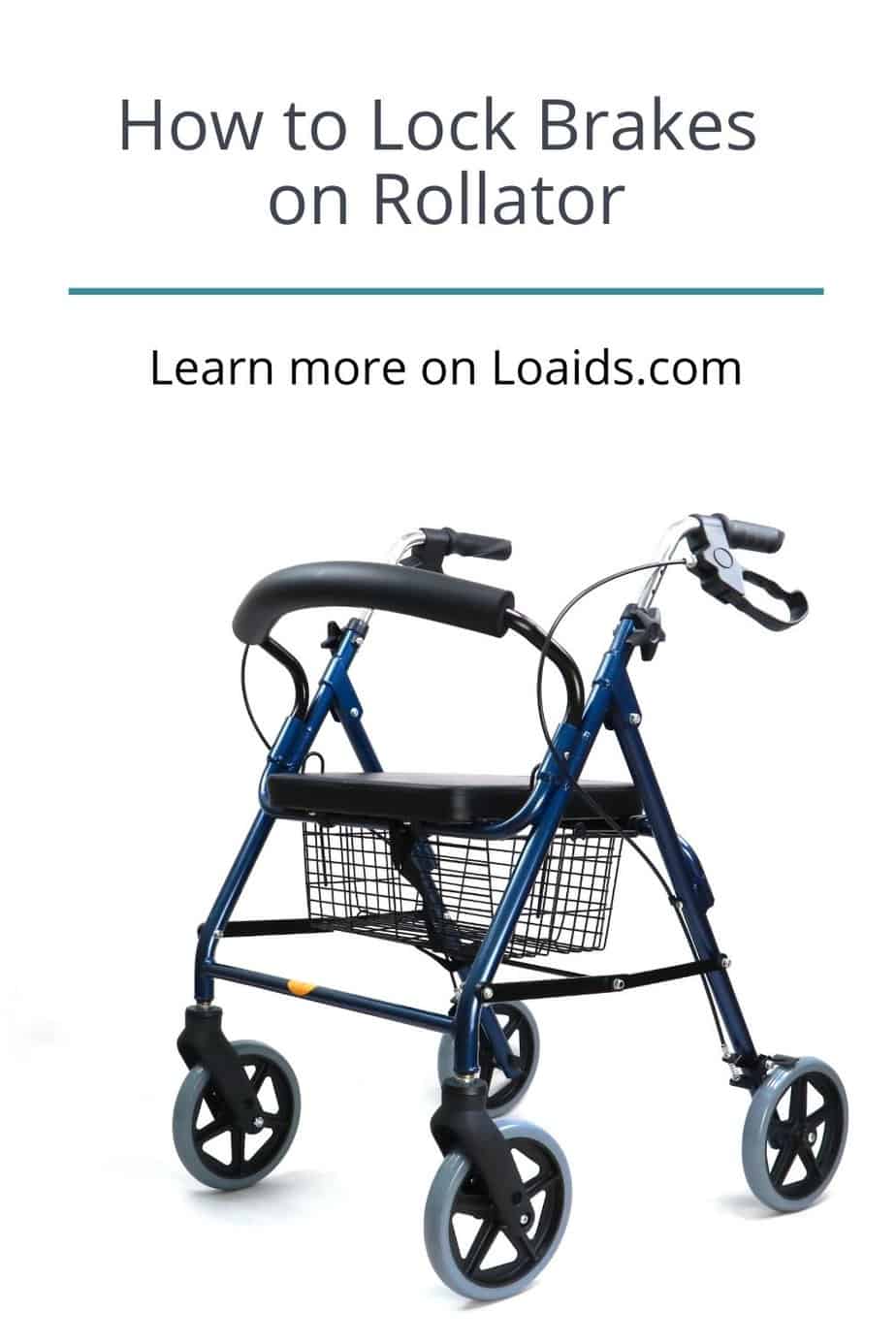A rollator is a mobility device similar to a walker but has wheels on all of its legs. (1)
After getting one for my grandfather, my family prioritized figuring out how to lock the brakes because understanding the breaking mechanism was crucial for his safety.
I researched the mechanics of working a rollator brake. Read on to discover what I learned so you can understand how it works and ensure your family’s safety.
Table of Contents
Key Takeaways:
- Rollator brakes are a vital component of rollator safety for individuals looking to use this type of mobility device.
- Most rollators have loop-lock brakes beneath their ergonomic handles to operate the braking system.
- Modern rolling walkers have a dedicated parking brake that you can activate by pushing the braking levers down.
CHECK: Rollator Walker With Seat Reviews
How to Lock the Brakes on a Rollator
To learn how to lock the brakes on a rollator, you should know that most rollator walkers have an easy-to-use loop-lock braking system.

You must reach beneath your rollator walker handles, grasp the braking loop, and pull it up.
A helpful thing to remember is that the braking system works like the bicycle brakes; you pull up the lever to engage the brakes.
That is why this braking system is also known as bicycle-style hand brakes.
On the other hand, grasping and squeezing the lever to bring it down releases the brake pads, allowing you to start moving again.
Note that these hand brakes are on both handles of a rollator. To make specific maneuvers, you can use both brakes at once or one at a time.
Also, keep in mind that using loop locks can be challenging for people without complete arm control.
Other Types of Rollator Locks
Single Hand Locks
This type of rollator brake works best for people with disabilities who cannot use both hands. Moreover, you can mount the brake on either side of the rollator’s handlebars. (1)
Push-down Locks
You must lean on the handlebars to engage the push-down brakes on a rollator. This can be convenient for bariatric patients and those with limited arm strength.
How to Lock the Wheels on a Rollator?
Most rollators have a dedicated park brake to lock the wheels against movement.
You can engage the parking brakes on walkers featuring a loop-locking mechanism by pushing down the brake lever.
You must note that the wheels won’t move until you pull up the levers. This is important as a safety feature to prevent falls among the elderly, which can have serious consequences. (2)
You can consult your manufacturer’s manual if you’re unsure where the dedicated park brake lever is.
Check out this YouTube video from Vive Health on how to engage and disengage the brakes on a rollator walker:
How Rollator Brakes Help in Turning
In addition to stopping a walker, rollator brakes can also help turn this mobility aid. You can make a sharper turn in tight spaces than maneuvering the whole device without brakes.
So, how do you use rollator brakes to help make tighter turns? You can turn tightly by engaging one brake while leaving the other free.
For instance, if you want to make a right turn, you will engage the right brake while leaving the left one free.
This action will nudge the rolling walker towards the right enabling you to turn safely.
You can also use the same principle to turn left. The brake you use depends on the direction you are taking.
Do Rollator Brakes Work Independently?
Most rolling walkers today have a set of hand-operated brakes on each handle. These brakes are usually connected independently of each of the rolling walker’s rear wheels.
Rollator brakes work independently, and you can use them simultaneously or one at a time.
Some rollator walkers have a single hand-operated brake connected to both wheels. Be sure to know which type of braking system your rollator has before using it.
Tightening and Loosening of Rollator Brakes
There may come a situation when you have to adjust the brakes on your rolling walker. You may have to either tighten or loosen the brakes to continue smooth usage.
Check out this YouTube video from Bob and Brad on how to adjust the brakes on your reliable mobility aid:
How to Tighten the Walker Brakes
You can adjust the rolling walker’s brakes on the handlebar area. You must locate the brake adjustment screw and loosen the brake adjustment lock nut to free the screw.
You will have to turn the screw counterclockwise to tighten the brakes. Ideally, check the braking intensity to prevent over-tightening.
How to Loosen the Walker Brakes
The brake loosening process on a rolling walker is similar to the tightening procedure. However, you must turn the brake adjustment screw clockwise to achieve the desired looseness.
While the focus here is on the brake system, many users often have questions about other aspects of rolling walkers, such as how to use a wheeled walker or how do you fold a rollator walker with a seat.
These are essential aspects to consider for overall functionality and convenience.
FAQs
1. How do you lock a rollator in place?
You can lock a rollator momentarily by pulling up the brake lever. However, you must engage the parking brake or push the brake down to lock the walker in place.
2. How do you use a walker without wheels?
You can use a walker without wheels by lifting the mobility aid when taking steps. Ideally, stay within the walker’s frame to avoid risking your safety.
3. Can you adjust the brakes on a rollator walker?
You can adjust a wheeled rollator’s brakes depending on the user’s health condition to regulate its speed on outdoor surfaces.
The process is simple and quick since you can adjust the brake handle.
4. Can you lock a rollator walker?

You can lock a wheeled rollator to prevent movement by using its brakes. Most rollators will have a standard brake and a dedicated parking brake control feature.
Conclusion
Understanding how to lock the brakes on a rollator is crucial to a walker’s ownership journey. Rollator brakes function as a protection feature to help the user have total control of their mobility.
So there you have it, an in-depth guide about rollator brakes, their operation, and other crucial information.
It is now up to you to share this crucial information with someone who may be looking to buy a walker but wondering about its braking system.

Resources
1. Boughner A. The Great Gait Debate: Walker Vs. Rollator – gograhamfield.com [Internet]. Go Graham Field. 2016. Available from: https://gograhamfield.com/walker-vs-rollator-great-gait-debate/
2. CDC: 1 in 4 US adults live with a disability [Internet]. Centers for Disease Control and Prevention. 2019. Available from: https://www.cdc.gov/media/releases/2018/p0816-disability.html
3. van Riel KMM, Hartholt KA, Panneman MJM, Patka P, van Beeck EF, van der Cammen TJM. Four-wheeled walker-related injuries in older adults in the Netherlands. Injury Prevention. 2013;20:11–5.




